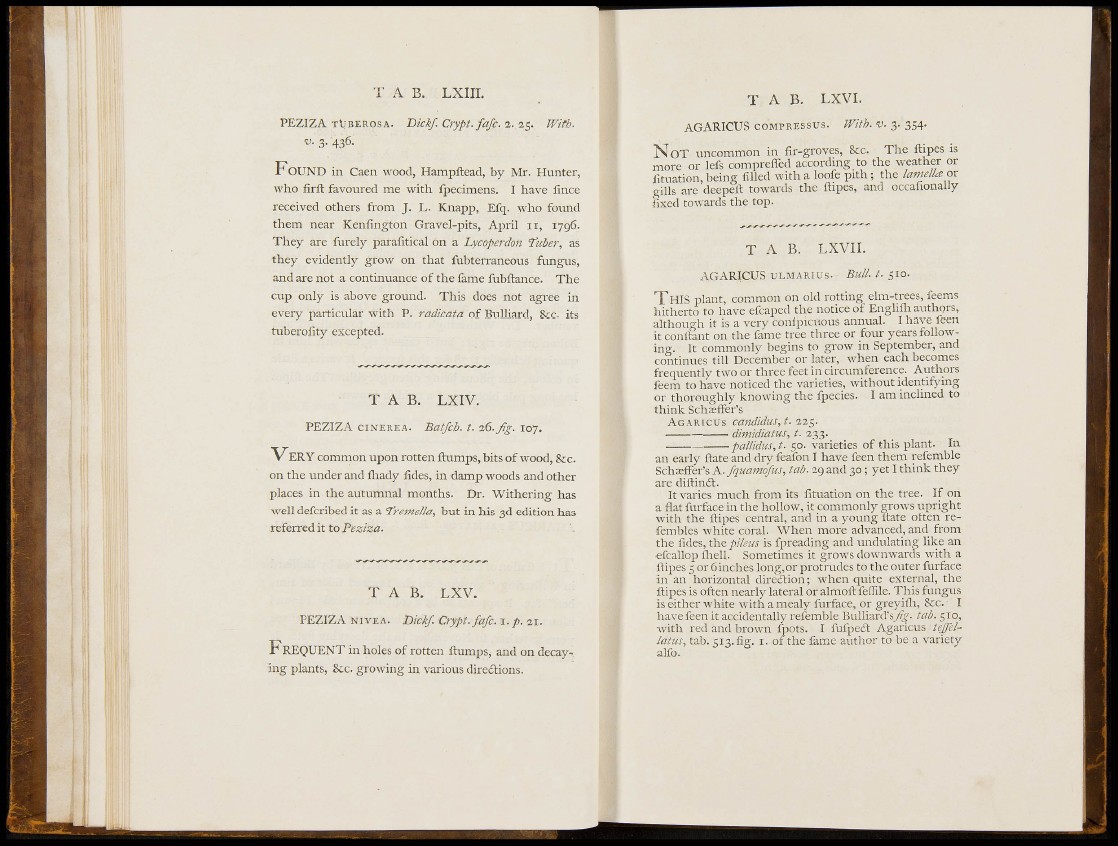
T A B. LXIII.
P E Z I Z A TtJBEROsA. DickJ. Crypt, fafc. i. 25. With,
v. 3. 436.
FOUND in Caen wood, Hampltead, by Mr. Hunter,
who firft favoured me with fpecimens. I have fince
received others from J. L. Knapp, Efq. who found
them near Kenfington Gravel-pits, April 11, 1796.
They are furely parafitical on a Lycoperdon 'Tuber, as
they evidently grow on that fubterraneous fungus,
and are not a continuance of the fame fubilance. The
cup only is above ground. This does not agree in
every particular with P. radkata of Bulliard, &c. its
tuberofity excepted.
T A B. LXIV.
PEZIZA ciNEREA. Batfch. t. 26. fg. 107.
"VERY common upon rotten fhimps, bits of wood, &c.
on the under and fliady fides, in. damp woods and other
places in the autumnal months. Dr. Withering has
well defcribed it as a tremella, but in his 3d edition has
referred it to Peziza.
T A B . LXV.
PEZIZA NIVEA. Dickf. Crypt, fafc. 1. p. 21.
FREQUENT in holes of rotten flumps, and on decaying
plants, &c. growing in various direilions.
T A B. LXVI.
A G A R I C U S COMPRESSUS. mth. v. 3. 354.
N O T uncommon in fir-groves, &c. The ñipes is
more or lefs comprefled according to the weather or
fituation, being filled with a loofe pith; the lamelloiox
gills are deepeft towards the ñipes, and occafionally
fixed towards the top.
T A B. LXVII.
AGARICUS uLMARius. t. CIO.
THIS plant, common on old rotting elm-trees, feems
hitherto to have efcaped the notice of Engliili authors,
although it is a very confpicuous annual. I have feen
it conftant on the fame tree three or four years following.
It commonly begins to grow in September, and
continues till December or later, when each becomes
frequently two or three feet in circumference. Authors
feem to have noticed the varieties, without identiftang
or thoroughly knowing the fpecies. I am inclined to
think SchiefFer's
AGARICUS cundidus, t. 225.
J-, t. 233.
pallidus, t. 50. varieties of this plant. In
an early ñate and dry feafon I have feen them refemble
Schrfer's A. fquamofus, tab. 29 and 30; yet I think they
are diñinét.
It varies much from its fituation on the tree. If on
a flat furface in the hollow, it commonly grows upright
with the ñipes central, and in a young ñate often refembles
white coral. When more advanced, and from
the fides, fiiapileus is fpreading and undulating like an
«fcallop fliell. Sometimes it grows downwards with a
ñipes 5 or 6 inches long, or protrudes to the outer furface
in an horizontal direction; when quite external, the
ñipes is often nearly lateral or almoft felTile. This fungus
is either white with a mealy furface, or greyillr. See. I
have feen it accidentally refemble Bulliard'sT^'. tab. 510,
with red and brown fpots. I fufpea Agaricus teffeU
latus, tab. 513. fig. i. of the fame author to be a variety
alfo.